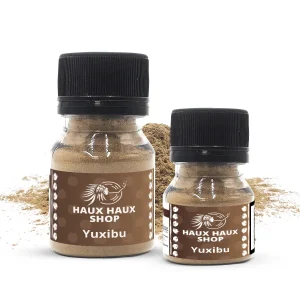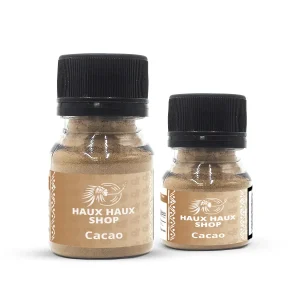Showing the single result
Showing the single result
Katukina Rapé
Sacred Indigenous Medicine from the Heart of the Amazon
Discover the ancient wisdom and healing power of authentic Katukina shamanic snuff
The Ancient Tradition of the Katukina People
The Katukina people are among the most respected indigenous tribes of the Amazon region, renowned for their profound connection to traditional indigenous medicine and their role as guardians of ancestral knowledge that has been passed down through generations. Belonging to the Pano linguistic family, these native peoples primarily inhabit the banks of the Campinas and Gregório rivers in the state of Acre, Brazil, where they maintain a millennial tradition of using sacred medicinal plants.
The history of the Katukina is marked by remarkable cultural resistance. Despite facing challenges imposed by rubber boom cycles and modernization pressures, they have managed to preserve their native language and traditional practices. This dedication to cultural preservation is especially reflected in their ancestral medicine, where Katukina rapé occupies a central place as one of the most important tools for healing and spiritual connection.
The social organization of the Katukina is structured into six distinct clans: Varinawa, Kamanawa, Satanawa, Waninawa, Nainawa, and Numanawa. Each clan has its own specific traditions and dietary prohibitions that strengthen collective identity and maintain the tribe’s social cohesion. This clan structure is fundamental not only for social organization but also for transmitting knowledge about indigenous rapé medicine, including the techniques for preparing and using sacred snuff.
What is Katukina Rapé
Katukina rapé is a traditional indigenous medicine prepared artisanally by the shamans and knowledgeable members of the Katukina tribe, following ancestral recipes transmitted orally through generations. This sacred powder is composed primarily of finely ground native tobacco leaves (Nicotiana rustica) mixed with ashes from specific medicinal trees, along with other aromatic and healing plants selected according to the tribe’s shamanic tradition.
The preparation of Katukina rapé is a ceremonial process that can take several days to complete. The tobacco is first cut into small pieces and dried over low fire, preserving its medicinal properties. Subsequently, ashes are obtained through controlled burning of sacred tree barks, such as Tsunu, which provide essential alkaline properties for the final composition. All material is then ground in wooden mortars for hours, in a meditative process that infuses healing intentions into the final product.
The result is an extremely fine powder, with a texture similar to 125 microns, with coloration varying between gray and beige, depending on the plants used in the composition. Unlike common commercial tobacco, Amazonian rapé uses native varieties of Nicotiana rustica, known locally as “Corda” or “Moi,” which possess psychoactive and medicinal properties much more potent than conventional tobacco.
The administration of Katukina rapé is done through specific traditional instruments: the kuripe, for self-application, or the tepi, when applied by another person. The powder is blown forcefully into the nostrils, in a process that may be initially uncomfortable but is considered essential to activate the medicinal and spiritual effects of the medicine.
Benefits and Properties of Katukina Rapé
Katukina rapé offers a wide range of benefits that encompass physical, mental, and spiritual aspects, being recognized by traditional indigenous medicine as one of the most effective tools for promoting integral well-being. The physical effects include deep cleansing of respiratory pathways, removing accumulated mucus and exerting potent antibacterial effects that help combat colds and respiratory infections.
Physical Benefits
Deep respiratory cleansing, headache and migraine relief, antibacterial properties, muscle tension reduction, and support for cold and infection recovery. The unique combination of sacred tobacco and medicinal plants in Katukina rapé provides significant relief from physical discomforts, especially headaches and migraines.
Mental Benefits
Enhanced mental clarity, improved focus and concentration, intuition stimulation, cessation of internal mental dialogue, and preparation for meditation practices. From a mental and cognitive perspective, Katukina rapé is widely valued for its ability to promote mental clarity and intense focus.
Spiritual Benefits
Energetic realignment, dense energy cleansing, connection with higher self, access to ancestral wisdom, and opening of spiritual channels. The spiritual benefits of Katukina rapé are considered by the Katukina as the most important.
The nicotinic content of Nicotiana rustica stimulates the release of neurotransmitters such as epinephrine, acetylcholine, and dopamine, resulting in greater concentration, mental presence, and intuitive capacity. Many practitioners report a sensation of “stopping internal dialogue,” creating a clean mental space receptive to meditation and spiritual practices.
The medicine is used for energetic realignment, cleansing of dense energies, and opening communication channels with higher spiritual dimensions. It is believed that rapé facilitates connection with the “higher self” and ancestral wisdom, providing profound insights and spiritual guidance.
Ethnobotanical studies suggest that Katukina rapé may have properties related to pineal gland decalcification, although this claim still requires more scientific research for confirmation. The pineal gland, known as the “third eye” in spiritual traditions, is involved in melatonin production and perception of altered states of consciousness.
How to Use Katukina Rapé
The proper use of Katukina rapé requires preparation, respect, and knowledge of traditional indigenous practices. Before application, it is fundamental to create a sacred and silent environment, free from distractions, where it is possible to maintain focus and intention throughout the entire experience. Mental preparation includes defining a clear intention for the session, whether it be physical healing, energetic cleansing, seeking insights, or simply spiritual connection.
For beginners in using Katukina rapé, it is recommended to start with very small amounts, approximately the size of a lentil, to allow the body to gradually become accustomed to the medicine’s effects. Application should preferably be done with the assistance of an experienced person who can administer the rapé through a tepi, ensuring proper dosage and technique.
The application process involves positioning the tepi or kuripe in the nostril and blowing the powder with sufficient force to reach the deep nasal cavities. It is normal to experience intense sensations immediately after application, including tearing, runny nose, and a “shock” sensation that may last several minutes. These reactions are considered a natural part of the cleansing and purification process.
After application, it is important to remain in a seated or lying position for at least 15 to 30 minutes, allowing the effects to develop completely. During this period, many people experience insights, visions, or simply a profound sensation of peace and connection. It is recommended to keep a journal of experiences to track benefits and patterns over time.
Traditional Application Methods
The kuripe is a V-shaped pipe used for self-application, allowing practitioners to administer rapé to themselves in a controlled manner. This method requires practice and familiarity with the medicine, as proper technique is essential for effective application. The tepi, on the other hand, is a straight pipe used when another person administers the rapé, which is often preferred for beginners or ceremonial contexts.
Traditional ceremonies often involve mutual administration between participants, creating a sacred bond and shared experience. The person administering the rapé takes on the responsibility of holding space and ensuring the recipient’s safety and comfort throughout the process. This practice emphasizes the communal and spiritual aspects of Katukina rapé use within indigenous traditions.
Katukina Culture and Spirituality
The indigenous spirituality of the Katukina is intrinsically connected to nature and the use of sacred medicinal plants, with rapé being one of the main tools for accessing expanded states of consciousness and communication with the spiritual world. For the Katukina, rapé is not just a medicine, but a spiritual being with its own consciousness, capable of teaching, healing, and guiding those who approach with respect and humility.
The indigenous rituals and Katukina ceremonies frequently incorporate the use of rapé as a central element for spiritual preparation and opening communication channels with ancestors and forest spirits. During these ceremonies, rapé is used in conjunction with other sacred medicines, such as kambo (frog secretion) and ayahuasca, creating a powerful synergy for healing and personal transformation.
The transmission of knowledge about Katukina rapé follows rigorous protocols within Katukina culture. Only the most experienced shamans and healers are authorized to teach the techniques of preparation and use of the medicine, ensuring that the tradition is preserved in its purest and most authentic form. This knowledge is considered sacred and its transmission involves not only technical aspects but also spiritual initiations and commitments to cultural preservation.
The Katukina believe that each plant used in rapé composition has a guardian spirit that must be honored and respected throughout the entire process, from collection to final use. This animistic view of nature permeates all Katukina culture and profoundly influences their relationship with traditional medicines.
Understanding the cultural context is essential for anyone interested in indigenous rapé traditions. The Katukina, like other Amazonian tribes such as the Huni Kuin and Nukini, maintain distinct practices while sharing common principles of respect for plant spirits and ceremonial use of sacred medicines.
Sacred Plant Relationships
The relationship between the Katukina and their medicinal plants extends far beyond simple utilitarian use. Each plant is considered a teacher and ally, with its own personality, preferences, and wisdom to share. This deep understanding of plant consciousness forms the foundation of Katukina shamanism and influences every aspect of rapé preparation and use.
The collection of plants for rapé preparation follows strict protocols that honor the plant spirits and ensure sustainable harvesting practices. Shamans perform specific rituals before collecting, asking permission from the plant spirits and offering tobacco or other sacred substances in exchange. This reciprocal relationship maintains the balance between human needs and environmental preservation.
Authentic Katukina Rapé – Quality and Origin
The authenticity of Katukina rapé is a fundamental aspect to ensure not only the medicine’s efficacy but also respect for the ancestral traditions of indigenous peoples. Original Katukina rapé is produced exclusively by the tribe members themselves, using plants collected in their traditional territory and following ancestral recipes transmitted orally through generations.
The superior quality of authentic Katukina rapé is directly related to the purity of ingredients used and the artisanal preparation process. Plants are collected at specific moments, following lunar calendars and permission rituals to forest spirits. The tobacco used is organically cultivated by the Katukina themselves, without the use of pesticides or chemical fertilizers, preserving their natural medicinal properties.
The drying and grinding process of Katukina rapé is performed completely manually, using traditional techniques that preserve the medicine’s energetic integrity. The time dedicated to preparation, which can take weeks, allows healing intentions to be infused into the final product, significantly differentiating it from industrialized products or imitations.
Ethical commercialization of Katukina rapé must always ensure that economic benefits return directly to the Katukina community, supporting their financial autonomy and preservation of their cultural traditions. When acquiring authentic Katukina rapé, consumers contribute to the tribe’s economic sustainability and maintenance of unique ancestral knowledge.
It is important to verify the provenance of Katukina rapé through suppliers who maintain direct and transparent relationships with the indigenous community, ensuring that the product is genuine and that its commercialization respects the rights and traditions of native peoples. Origin traceability is fundamental to avoid counterfeit products that may not only be ineffective but also disrespectful to Katukina culture.
Supporting Indigenous Communities
Purchasing authentic Katukina rapé directly supports the economic independence of indigenous communities and helps preserve their traditional way of life. Fair trade practices ensure that the Katukina receive appropriate compensation for their knowledge, labor, and sacred medicines, enabling them to maintain their cultural practices while meeting modern economic needs.
The sustainable harvesting and preparation of Katukina rapé also contributes to rainforest conservation efforts. By maintaining traditional land use practices and protecting their ancestral territories, the Katukina serve as guardians of biodiversity and environmental stewardship in the Amazon region.
Experience Authentic Katukina Rapé
Discover the healing power of traditional Amazonian medicine with our carefully sourced, authentic Katukina rapé collection.
Explore More Indigenous Medicines
Other Rapé Varieties
- Huni Kuin Rapé – Traditional Huni Kuin medicine
- Yawanawá Rapé – Sacred Yawanawá tradition
- Nukini Rapé – Nukini tribal medicine
Shamanic Tools
- Kuripes & Tepis – Application tools
- Snuff Bottles – Storage containers
Other Medicines
- Sananga – Traditional eye medicine
- Natural Incense – Sacred aromatics
Learn More
- Blog Articles – Educational content
- Indigenous Peoples Institute
- FUNAI – National Indigenous Foundation




